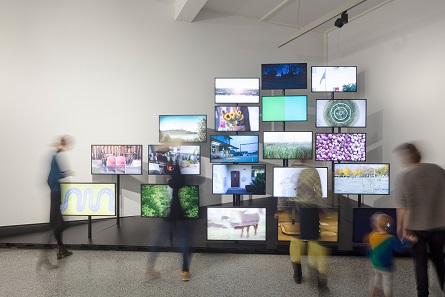March 7, 2019 – Even though the city hasn’t always been the biggest in the country, Zurich has played a major role in Switzerland’s history over the centuries: as a royal palace in the High Middle Ages, an imperial city in the Late Middle Ages, a centre of the Reformation in the early modern period, a stronghold of liberalism in the 19th century, and finally a national economic hub in the 21st century. Perhaps precisely for that reason, Zurich has repeatedly been in conflict with the rest of Switzerland – there was the Old Zurich War in the mid-15th century, the denominational split in the 16th and 17th centuries, the move towards democracy in the 19th century, and the journey to becoming the metropolitan region of today. The ‘Simply Zurich’ exhibition takes each of these topics and examines it in depth. The new permanent exhibition, covering three rooms of the National Museum, tells the tale of back then and the here and now, of city and canton, and of the seen and unseen. The exhibition is not encyclopaedic; rather, it drills down into the deepest layers of Zurich’s history and curves back to the present.
A view of the exhibition. Photo: Jan Bitter / Holzer Kobler Architekturen.
The New Permanent Exhibition
Visitors are greeted by 20 video portraits of Zurich communities. The mini-films showcase the canton’s diversity in a playful and subjective way. They are supplemented by an installation set up by a group of artists called mickry3, which brings together the tourist hotspots of Zurich in a single imposing sculpture.
A view of the exhibition. Photo: Jan Bitter / Holzer Kobler Architekturen.
At the heart of the new permanent exhibition is a type of treasure chamber containing 60 objects, which are in turn the starting point for 60 illustrated stories. Subjects range from political power struggles in historic Zurich to love for Züri-Leu, to the present-day creative economy – always in search of just what it is that makes Zurich Zurich.
A view of the exhibition. Photo: Swiss National Museum.
The display cabinet of the treasure chamber already has room for further objects and topics, allowing the Museum to gradually expand and consolidate this Zurich cosmos in the coming years.
A view of the exhibition. Photo: Jan Bitter / Holzer Kobler Architekturen.
The third room is taken up by four cinematic presentations, which have been created by architects from ETH Zurich on the basis of point cloud technology. A point cloud consists of a huge number of measured points which enables users to model landscapes and spaces in a completely new way. It becomes possible to penetrate solid matter, glide through walls and create surprising connections: the Töss Valley throughout industrial history, for instance, or the Lindenhof, once the site of the proud castle of the city’s rulers, beneath which can now be found not only traces of Roman Turicum, but also the Urania car park.
Some of the items and images shown in “Einfach Zürich” include:
Sturmwand, a large stationary shield, or Setzschild, for crossbowmen, around 1440. Photo: ‘Simply Zurich’ Association / Mara Truog.
War at Lake Zurich, 1444. From the Swiss Chronicle (Eidgenössische Chronik), which was compiled by Werner Schodoler between 1510 and 1535. Photo: Municipal archives, Bremgarten.
View of the locomotive assembly hall of the Schweizerische Lokomotive- und Maschinenfabrik (SLM, the Swiss Locomotive and Machine Works) in Winterthur, around 1900. Photo: Sulzer Archive.
A Swissair DC-2 at Dübendorf, 1935. Photo: ETH Image Archive.
Urban life at Zurich’s Hardbrücke station. Photo: Zurich Tourism / Adrian Bretscher.
Programme
“Einfach Zürich” is more than just an exhibition. It builds a bridge to a host of other institutions, large and small, throughout the canton which deal with Zurich’s history. Each year, a two-person curatorial team will put together a programme in cooperation with partners in the city and canton. An annual focus area will be selected.
In 2019 the programme, which will start in the middle of the year, will be called ‘Wildes Zürich’ (Wild Zurich): Zurich is considered orderly, Protestant, hard-working, clean – but is it also wild? This particular programme was inspired by the establishment of the zoo in the Sihlwald 150 years ago. The wilderness has been domesticated right on Zurich’s doorstep. It shows how diverse the wilderness is in people’s minds and in reality. And how varied a cultural programme on this topic can be.
More information about the new permanent exhibition is available on the official website.













